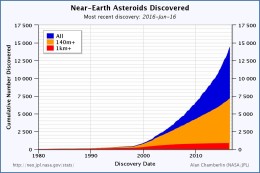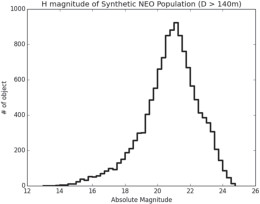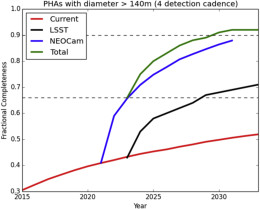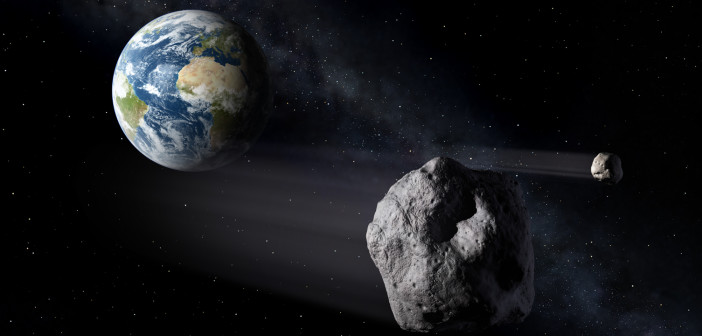How can we hunt down all the near-Earth asteroids that are capable of posing a threat to us? A new study looks at whether the upcoming Large Synoptic Survey Telescope (LSST) is up to the job.
Charting Nearby Threats
LSST is an 8.4-m wide-survey telescope currently being built in Chile. When it goes online in 2022, it will spend the next ten years surveying our sky, mapping tens of billions of stars and galaxies, searching for signatures of dark energy and dark matter, and hunting for transient optical events like novae and supernovae. But in its scanning, LSST will also be looking for asteroids that approach near Earth.

Cumulative number of near-Earth asteroids discovered over time, as of June 16, 2016. [NASA/JPL/Chamberlin]
Recognizing the potential danger that NEOs can pose to Earth, Congress has tasked NASA with tracking down 90% of NEOs larger than 140 meters in diameter. With our current survey capabilities, we believe we’ve discovered roughly 25% of these NEOs thus far. Now a new study led by Tommy Grav (Planetary Science Institute) examines whether LSST will be able to complete this task.

Absolute magnitude, H, of a synthetic NEO population. Though these NEOs are all larger than 140 m, they have a large spread in albedos. [Grav et al. 2016]
Can LSST Help?
Based on previous observations of NEOs and resulting predictions for NEO properties and orbits, Grav and collaborators simulate a synthetic population of NEOs all above 140 m in size. With these improved population models, they demonstrate that the common tactic of using an asteroid’s absolute magnitude as a proxy for its size is a poor approximation, due to asteroids’ large spread in albedos. Roughly 23% of NEOs larger than 140 m have absolute magnitudes fainter than H = 22 mag, the authors show — which is the value usually assumed as the default absolute magnitude of a 140 m NEO.

Fraction of NEOs we’ve detected as a function of time based on the authors’ simulations of the current surveys (red), LSST plus the current surveys (black), NEOCam plus the current surveys (blue), and the combined result for all surveys (green). [Grav et al. 2016]
The authors find that, within 10 years, LSST will likely be able to detect only 63% of NEOs larger than 140 m. Luckily, LSST may not have to work alone; in addition to the current surveys in operation, a proposed infrared space-based survey mission called NEOCam is planned for launch in 2021. If NEOCam is funded, it will complement LSST’s discovery capabilities, potentially allowing the two surveys to jointly achieve the 90% detection goal within a decade.
Citation
T. Grav et al 2016 AJ 151 172. doi:10.3847/0004-6256/151/6/172

